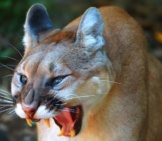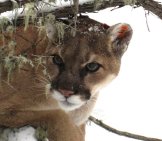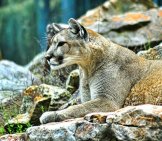Mountain lions are a cat of many names. They are also known as cougars, pumas, panthers, and catamounts. It is no wonder they are known by so many names, as their range is so expansive, from Canada to South America. They are known by many different names in different regions. Across this range they are both respected, and feared. Read on to learn about the mountain lion.
Description of the Mountain Lion
These felines are quite large. In fact, they are the fourth-largest cat species in the world, behind tigers, lions, and jaguars. They can stand up to 35 in. at the shoulder, that’s nearly 3 ft. tall! With their tails, some individuals can be as much as 9 ft. long. This cat’s fur is tawny yellow, with patches of reddish or silver in some regions.
Interesting Facts About the Mountain Lion
Mountain lions are some of the most widespread of all large, terrestrial mammals. Their vast range has made them notoriously feared across various regions. Though they are powerful predators, they are also an intriguing and important species.
- Not a “Big Cat” – Despite their large size, scientists do not consider mountain lions “big cats.” Though they are literally a big cat, the term “big cat” usually refers to large, roaring felines. Instead of roars, cougars hiss, growl, chirp, purr, and even scream.
- Big Prey – These cats use their large size to take down some impressive prey. Generally speaking, the larger the cat, the larger prey they can take on. They will capture elk, moose, deer, bighorn sheep, and other large mammals.
- Population Control – Large predators – like cougars, wolves, and bears – are an important part of the ecosystem. Prey populations, like deer, can quickly escalate when predators die out. This increases disease, and damages the plant life in an ecosystem.
- Artificial Control – Though recreational hunting of deer and other large game helps reduce populations, it is far from a perfect system. When hunting for sport, humans target the largest, strongest, animals. However, this is bad for the genetics of the population. Natural predators, like cougars, are important because they pick off the weak and the sick. When only the strongest survive to reproduce, the population is healthier.
Habitat of the Mountain Lion
Mountain lions are kings of adaptability. Part of the reason they have such a wide range is because of their ability to adapt to different habitats. You can find these predators in nearly every North American habitat. They live in deserts, mountains, lowlands, mangrove forests, deciduous forests, canyons, prairies, and more. When given the opportunity, their preferred habitats have rocky outcrops or dense vegetation to ambush prey from.
Distribution of the Mountain Lion
These widespread cats have one of the largest ranges of any terrestrial animal in North and South America. From Canada, populations of mountain lions live all the way to the tip of South America. Their range stretches from Canada all the way to South America.
The northernmost reach of their range is the Canadian Yukon. In North America, they are more concentrated to the western states. Save for Florida, humans have removed them from the vast majority of the eastern United States and Canada.
Diet of the Mountain Lion
Like most cats, cougars are obligate carnivores. This means that they must eat meat to survive, and the vast majority of their diet consists of meat. To capture enough prey to survive, these cats must be opportunistic. They prey on anything from insects and rabbits, to 1,500 lb. bull moose. Some commonly targeted species include deer, elk, moose, bighorn sheep, horse, pronghorn, mountain goat, and caribou.
Mountain Lion and Human Interaction
Interactions between mountain lions and humans negatively impact both. On one hand, the cats will sometimes attack livestock, and even humans. On the other hand, humans kill mountain lions for a number of reasons.
In some areas, hunting these cats is legal, and in other areas, more indirect factors impact them. Deforestation and habitat destruction pose a problem, because these cats thrive in areas where they can ambush their prey. Though the population is stable, some regional subspecies are endangered or extinct.
Domestication
Humans have not domesticated mountain lions in any way.
Does the Mountain Lion Make a Good Pet
No, mountain lions do not make good pets. Large, toothy predators tend to be dangerous as household pets! It is also illegal in most places to own one of these cats as a pet.
Mountain Lion Care
In zoos, these cats can nearly double their life expectancy. While wild cougars usually have a 10-year lifespan at the most, those in zoos can live to 20 years or more. This is because zookeepers provide them with a reliable food source, and unlimited healthcare.
Zoos have commercially available ground meat, which provides all the vitamins and nutrients needed for survival. Additionally, they receive rabbits, large bones, and parts of carcasses. The exhibits built for these cats are spacious, and usually provide a number of rocky features or climbing opportunities.
Behavior of the Mountain Lion
Mountain lions are solitary creatures, and outside of mating, adults rarely interact. However, individuals with bordering territories will occasionally share kills. An animal that shares a kill with its neighbor increases the likelihood the neighbor will share a kill in return. They mark territories with urine and claw scraping, and these territories can vary greatly in size based on food abundance.
Reproduction of the Mountain Lion
Female mountain lions will usually only reproduce once every two or three years. The gestation period is approximately three months, and the female takes the sole responsibility of rearing the young. Litters of two kittens are the most common.
When they are born, the kittens are blind and helpless. By the time they are three months old, the kittens will begin to eat meat and stop drinking milk. Once they are six months old, the kittens will begin to hunt their own prey. They will hone their skills, and remain with their mother, for at least two years before setting off on their own.
Beliefs, Superstitions, and Phobias About the Mountain Lion
The indigenous people of North, Central, and South America, revere and respect these powerful cats. Various native people have stories and mythology relating to mountain lions, from the Cherokee to the Incan people. In some regions they considered the cat a harbinger of death, while in others they regarded it as a deity or sacred animal.













![Red Angus Closeup of a beautiful Red Angus cowPhoto by: U.S. Department of Agriculture [pubic domain]https://creativecommons.org/licenses/by/2.0/](https://animals.net/wp-content/uploads/2020/03/Red-Angus-4-238x178.jpg)












![Red Angus Closeup of a beautiful Red Angus cowPhoto by: U.S. Department of Agriculture [pubic domain]https://creativecommons.org/licenses/by/2.0/](https://animals.net/wp-content/uploads/2020/03/Red-Angus-4-100x75.jpg)

